[To the extent that readers, especially other writers on photography, have come to see this blog as a locus for debunking photo-related myths and/or presenting their research and commentary on overlooked subjects, I’m gratified. In that vein, this fall’s first Guest Post comes from Andrew Molitor, a regular blogger himself and occasional respondent to what gets posted here.
One lesson I take away from Molitor’s research concerns the imperative of close and careful reading — of written texts, as well as of visual images — as the necessary premise for critical thinking in regard thereto. — A.D.C.]
•
The Case of the Appropriate Alarm Clock
by Andrew Molitor
In 1936, photographer Walker Evans and writer James Agee, on assignment from Fortune magazine, traveled to Hale County, Alabama to study the lives of the tenant farmers (“sharecroppers”) there. They photographed, interviewed, and lived with three families there over a period of some weeks. While the article they’d been commissioned to produce was never published, the book Let Us Now Praise Famous Men was published in 1941, based on the collected material. The book comprises photographs by Walker Evans illustrating certain details of the families’ lives, and text written by James Agee covering an overlapping, but not identical, set of details.
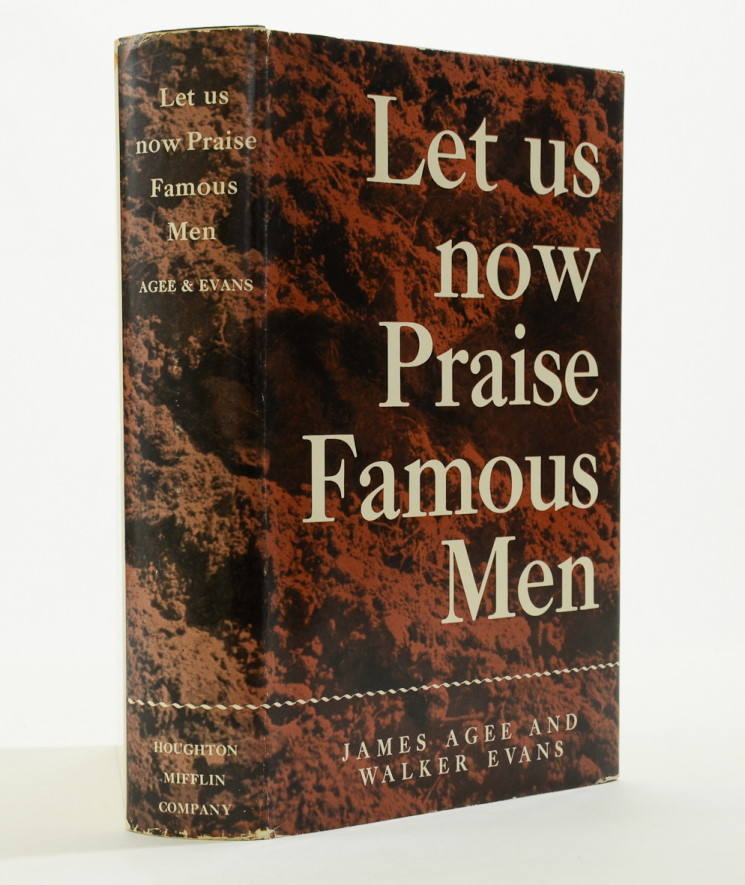
James Agee & Walker Evans, Let Us Now Praise Famous Men (1941), cover
The tenant farmer families in question were given pseudonyms (Gudger, Ricketts, Woods) in the book. I will be referring only to the “Gudger” family. Because several sources with varying usages are in play here, I will instead use their actual name, Burroughs, in favor of the pseudonym.
At this time Evans was working for the Resettlement Administration, a government agency soon to be renamed the Farm Security Administration (FSA). In order to free Evans for this project, Roy Stryker (to whom Evans reported) negotiated with Eleanor Tracy, art director at Fortune magazine, to release Evans on unpaid leave. Fortune would have first rights to the photos, but afterwards the photos would belong to the government.[i] Accordingly, these photos wound up in the FSA’s archive.
•
In 1991, historian James Curtis published a book entitled Mind’s Eye, Mind’s Truth: FSA Photography Reconsidered, in which he argues that the FSA’s photography project is not meaningfully an objective or truthful record of its time, but rather was consciously shaped to present a message in support of the FSA in particular, and the New Deal in general. At this moment in time, some 30 years later, Curtis’s position is not seriously disputed.
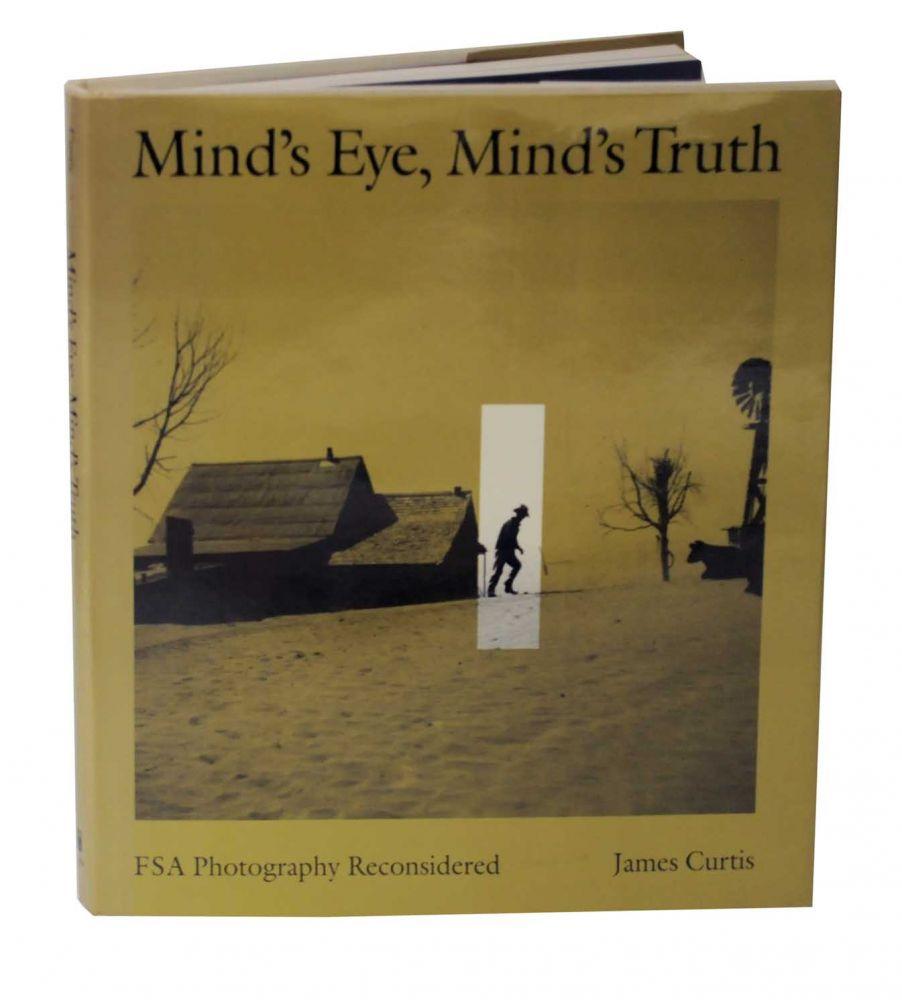
James Curtis, Mind’s Eye, Mind’s Truth (1991), cover
While Curtis does spend some time describing the myriad ways in which photographs and collections of photographs can be shaped, his focus is largely on allegations that FSA photographers specifically shaped the scenes they depicted. That is, rather than focusing on, for example, the ways in which an entire archive can be shaped through culling, Curtis is interested in the ways individual photos were in some meaningful way “faked.”
Curtis is interested in proving that objects were added, moved, or removed. He is interested in arguing that human subjects were coached, or directed. For much of the book Curtis is on fairly firm ground. Written records exist that describe the ways scenes were manipulated by some of the FSA photographers, and Curtis does valuable work in pulling together these records and interpreting them.
•
Walker Evans was one of the more notable members of the FSA staff, a bright light among many, and as such it seems that Curtis felt it necessary to have a go at him. This proved difficult, because there is little written material supporting Evans’s photographs. Evans’s output from this phase of his work consists of piles of negatives in the form of 8×10 sheets and 35mm strips, largely innocent of the kinds of notes and documents supporting much of the other work in the FSA files.
Curtis’s efforts to demonstrate that Evans manipulated objects and people for his photographs amount invariably to simply looking at groups of related photos (that is, multiple photos of the same or similar scenes); placing them in an imagined but plausible shooting sequence; and then devising a story to fit that sequence. As a methodology, this is less sturdy than his efforts elsewhere in his book. Indeed, Curtis’s thesis is that there is a large gap between what we think we can know from a photograph and what we can actually know. This makes it curious indeed that he would deploy such methods here.
My aim in these remarks is to demonstrate that one specific claim Curtis makes regarding Evans’s photos is simply false. Had the claim remained embalmed in Curtis’s book, I would be more willing to let sleeping dogs lie, but unfortunately it did not.
•
In 2009, the filmmaker Errol Morris published a series of articles entitled “The Case of the Inappropriate Alarm Clock” online in the blog pages of The New York Times. This series of articles was later edited into a book, Believing is Seeing (Observations on the Mysteries of Photography), published in 2011. In his book, Morris reiterates some of the arguments Curtis made, and supplements them by interviewing Curtis himself. Morris’s book, it should be noted, covers rather broader ground than Curtis’s and has a different focus. Morris is interested in how we make and mis-make meaning from photographs in general; Curtis is directly attacking the FSA photo archive’s objectivity.
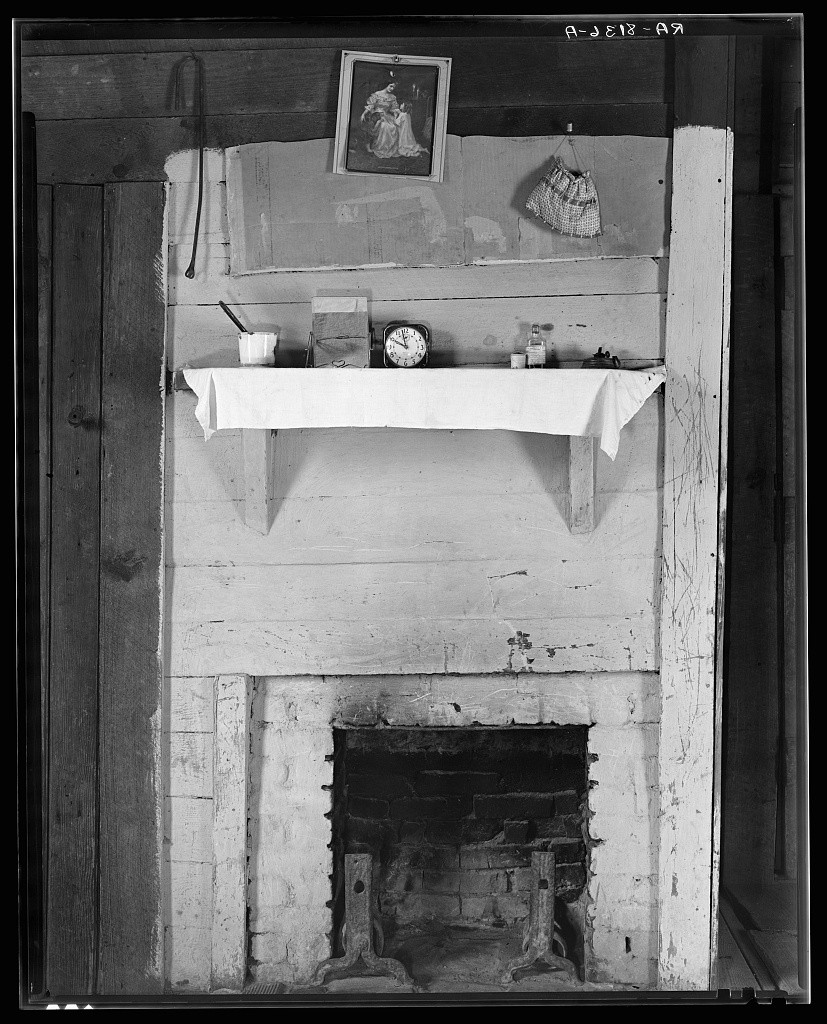
Walker Evans, Fireplace with Arrangement of Objects on Mantel in Floyd Burroughs Home, Hale County, Alabama, 1936
•
The claim of interest made by Curtis, echoed by Morris, is that Evans planted a small alarm clock on the mantel depicted in one of his photographs of the Burroughs house. Curtis bases this claim on the fact that Agee does not mention the alarm clock in a specific passage from Let Us Now Praise Famous Men.
It is certainly the case that the clock is not mentioned in the cited passage. Curtis writes about the clock, “Agee makes no mention of this object. Perhaps he overlooked it, although the exhaustive and exact nature of his inventory suggests otherwise. More likely, Evans added the clock, perhaps to establish a sense of the specific, the concrete, in an otherwise timeless scene.”[ii] You can see here Curtis’s habit of inventing actions and imputing to Evans equally invented motives for them. This tends to create the illusion that the invented action is established, and it is only the motive he is speculating on.
On the face of it, this is stronger evidence than you might expect; Agee did indeed provide a detailed inventory of exactly the mantel pictured, and most of the items in Agee’s inventory do appear in the photograph. Not, however, the clock. Curtis reiterates in his interview with Morris the statement that the clock is not referred to in the book, and Morris appears to agree. Curtis: “The alarm clock. James Agee does not mention the clock and it’s in the middle of that mantel. Now, if Agee is going to point out ten paper clips in the bottom of the shaving mug, he’s not going to forget about an alarm clock.”[iii] I do not think that at any point either Morris or Curtis actually make the claim that this clock is not mentioned anywhere in Agee’s book, only that it is not mentioned in the inventory passage. One might be forgiven for assuming that they meant the broader statement, however. This will turn out to be important.
•
A little later on in his book, Morris investigates the alarm clock itself, and concludes that it was likely too expensive for the Burroughs family to own: “The Fortune No. 10 was the budget alarm clock, but it would still cost about $23.93 in today’s dollars, a large sum to the struggling Gudger [Burroughs] family.”[iv] Morris, somewhat offensively, goes on to wonder out loud what the family would even want with an alarm clock. Morris concludes this discussion with the idea that there are three options: that the clock is Evans’s, that it was a gift from Evans to the Burroughs family, and that it was theirs all along. We will see shortly that Morris’s third option was true all along.
Morris then proceeds to detail his investigations of the four known photos of the same scene. Curtis included two of them in his book and constructed a fanciful story of how they were shot, without noticing that the times shown on the clock contradicted his story. Morris in his turn observes that the narrative Curtis constructed cannot be true. He notes that two of the pictures were shot at 9:40-ish, and two at 12:40-ish, clock-time.
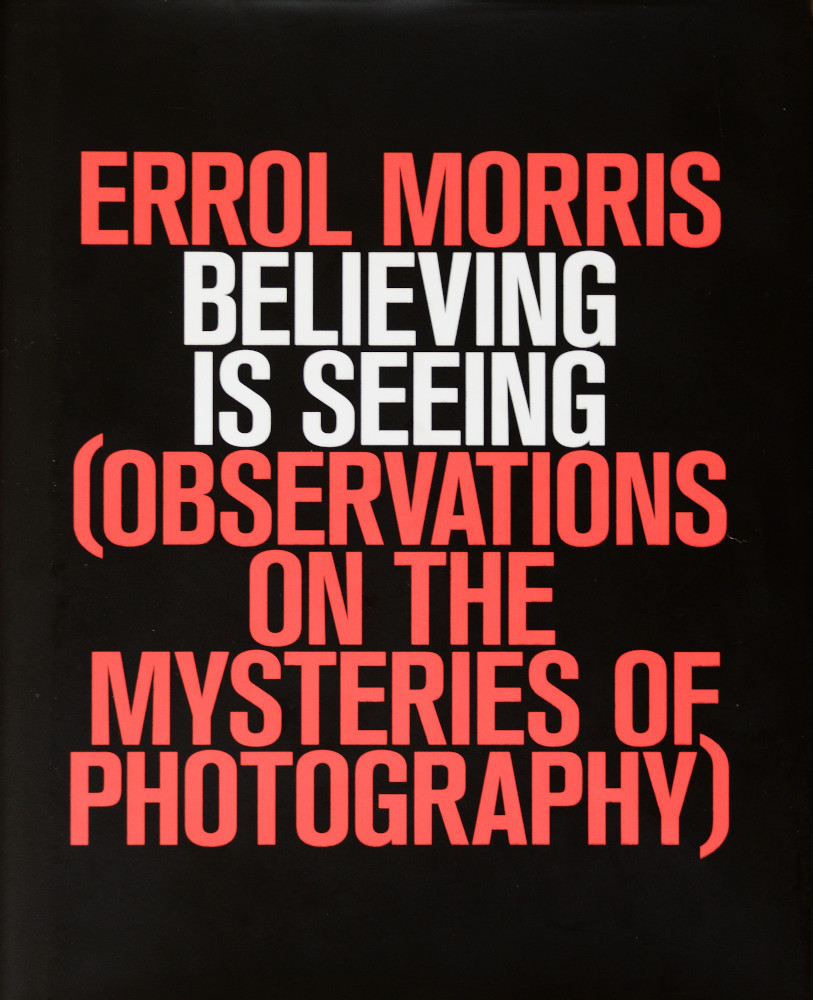
Errol Morris, Believing is Seeing (2011), cover
Morris constructs further stories that respect the time on the clock. For some reason, though, he assumes that all four photos were made on the same day. Morris writes, “Just as Curtis finds a reason for a certain photographic order by imagining what Evans was thinking, there are other scenarios that may explain an alternative order: Had Evans sat down for lunch and then noticed the sunlight had illuminated the left wall next to the fireplace?”[v] Morris provides no explanation for the fact that every single object on the mantel has moved between the two groupings.
It seems likely that in fact the two sets of photos were made on two different days, and that the Burroughs family had used and replaced the various items on the mantel. The mantel is one of the few general-purpose flat surfaces available. The house has no end tables, very little in the way of shelving, and so on. The mantel is where the daily-use toilet items were placed. Look, now I’m doing it! I, too, am constructing fanciful stories! My stories get no closer to the ground truth of the photo than any of the others, not really. None of the stories will turn out to matter much.
It may be useful to remind the reader at this point that Morris’s articles for The New York Times were entitled “The Case of the Inappropriate Alarm Clock,” which title also appears as a chapter head in his book. Morris’s position is, I think, quite clearly against the idea that the Burroughs family owned an alarm clock. He does not accept his own third option as credible, any more than Curtis does. How on earth both Morris and Curtis managed to convince themselves of this, against all the efforts of Occam’s Razor, is something of a mystery itself. Nevertheless, the situation is even worse than that.
•
What makes this whole episode remarkable is that neither Curtis nor Morris ever seems to have looked beyond the inventory Agee provided in the above-cited passage. About 30 pages before that inventory[vi] there is a section entitled “The house is left alone,” opening the chapter “The Gudger House.” In this passage Agee experiences the Burroughs house as it stands empty of people other than himself.
At the end of this passage we find a still-smoking gun: “… and it is now my chance to perceive this, their home, as it is, in whose hollow heart resounds the loud zinc flickering heartbeat of the cheap alarm two hours advanced upon false time; …”[vii]
Agee wrote, as he often did, poetically, in a hyper-literary style. Nevertheless, the phrase “cheap alarm” cannot in this context realistically apply to any object other than an inexpensive alarm clock. The remark that this clock is “two hours advanced on false time” seems to mean that the clock is set two hours fast. This is consistent with a clock belonging to a farmer with no reference to whatever “correct” time is, but surely less so with a clock belonging to an educated photographer with a car.
Finally, there is simply no way that Agee would metaphorically connect a clock belonging to Evans with the heart of the Burroughs house.
•
This passage was available to both Curtis and Morris, neither of whom seem to have discovered it. If they did, they somehow failed to notice its significance. It’s right there in the book.
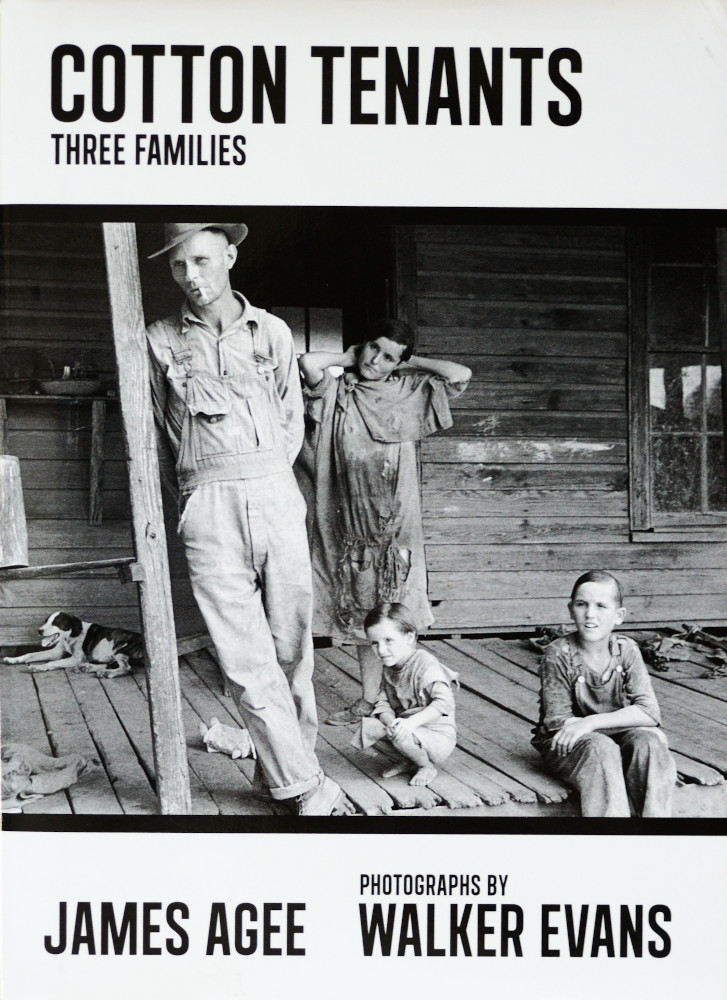
James Agee and Walker Evans, Cotton Tenants (2013), cover
A version of the article Agee intended to submit to Fortune was discovered and eventually itself published in book form in 2013, well after both Curtis and Morris had published their books. This slender volume, Cotton Tenants: Three Families, contains this footnote by Agee: “Though each family has a lowprice alarm clock and as a rule keeps it wound and is respectful of it, the clock is almost invariably an hour or two fast or slow, and they are innocent of any time except the sun’s[.]”[viii]
This seems to rather drive the point home. While it remains possible that Evans planted the alarm clock, or for that matter reconstructed the entire scene in a warehouse in New York City, the argument both Curtis and Morris make has collapsed. The Burroughs family did own an alarm clock, and it is most likely that one that appears in the photo.
•
[Editor’s note: I’m struck by something implicit in the attention paid to this clock in the responses thereto from Agee, first, and then Curtis and Morris. What fundamental incuriosity allows them not to ask the obvious question: In their circumstances, why did the Burroughs have a clock at all — especially with no way to keep it set to the correct time? I can think of only one regular situation for which they would have considered it important to be “on time”: Sunday morning church services (assuming they were churchgoers — I don’t have the book handy to check on that, but it seems likely). Aside from that, nothing in their lives that I can think of required clock-based punctuality. Perhaps that mystery is what makes it, as Barthes would have it, the punctum of this image. — A.D.C.]
•
Notes:
[i] Belinda Rathbone, Walker Evans: A Biography (First Mariner Books, 2000), p. 121.
[ii] James Curtis, Mind’s Eye, Mind’s Truth: FSA Photography Reconsidered (Temple University Press, 1991), p. 39.
[iii] Errol Morris, Believing is Seeing (Observations on the Mysteries of Photography), (The Penguin Press, 2011), p. 144.
[iv] Ibid., p. 144
[v] Ibid., p. 150.
[vi] James Agee, Let Us Now Praise Famous Men (Mariner Books, 1941, edition 2001), p. 152.
[vii] Ibid., p. 121.
[viii] James Agee, Cotton Tenants: Three Families (Melville House, 2013), p. 89.
•

Andrew Molitor
Andrew Molitor is a long-retired mathematician and more recently retired software engineer. He lives in Bellingham, WA, with his wife, two daughters, and a dog. He is now a full-time father and walker of the dog. He takes photographs, and from time to time tries his hand at photography criticism and historical research.
For more of his writing on photography, see this selection at The Luminous Landscape. He can be reached at amolitor_(at)_molitor-design(dot)com.






Well done Andrew!